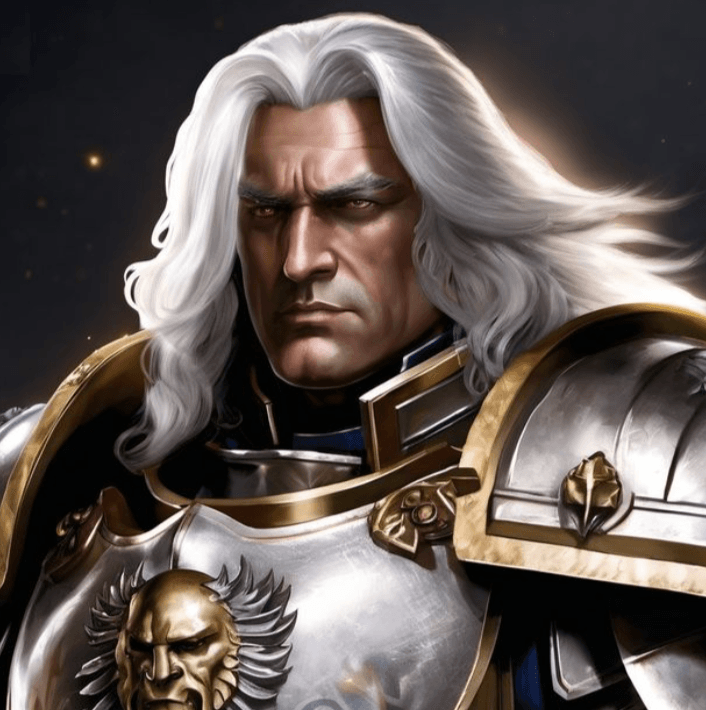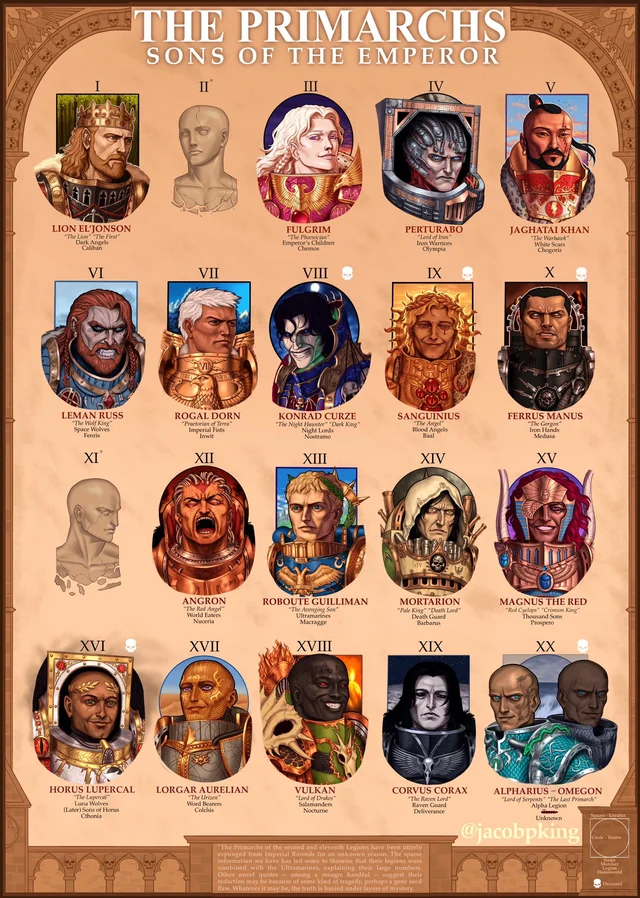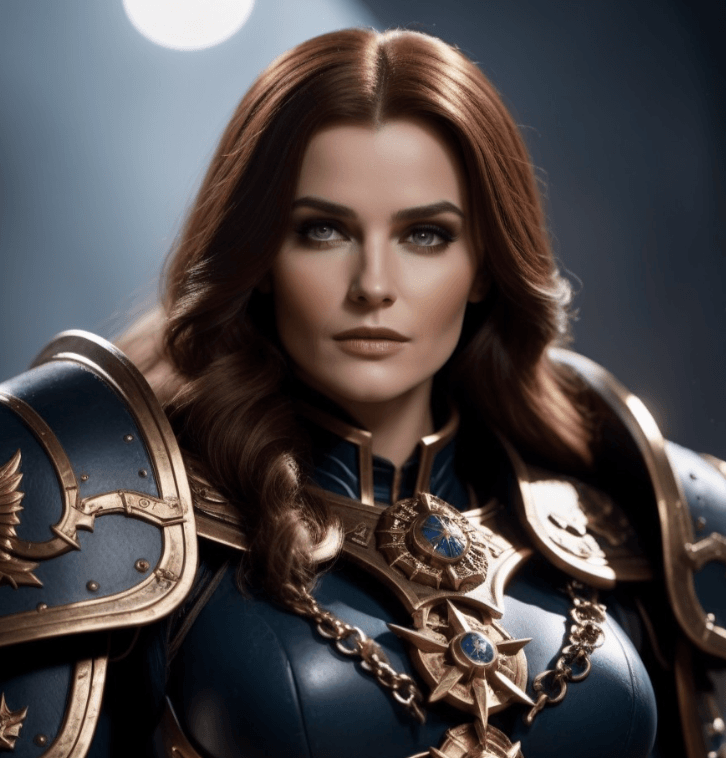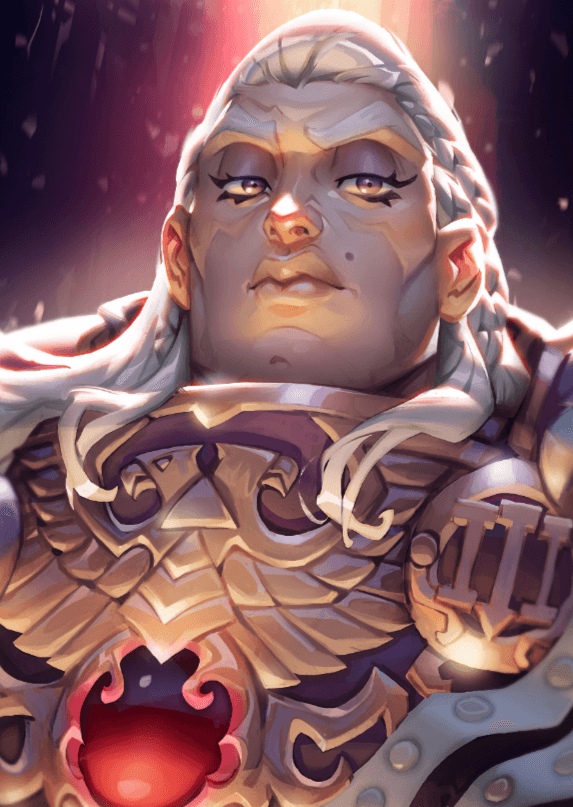For those of us who have been entrenched in the world of Warhammer 40k for years, few figures loom as large or are as awe-inspiring as the Warhammer Primarchs. As the cornerstone of Warhammer lore, the Primarchs are a complex blend of mythology, science fiction, and tragedy. These larger-than-life figures are more than just characters in a game—they’re the embodiment of the Emperor of Mankind’s grand design, the fractured legacy of the Imperium, and a symbol of the eternal battle between loyalty and corruption.
The Warhammer Primarchs are not just central to the narrative of the Warhammer 40k universe but also serve as the genetic “fathers” of the Space Marine Legions. Crafted by the Emperor himself, each Primarch was imbued with extraordinary abilities—superhuman strength, intelligence, resilience, and charisma. They were meant to be the Emperor’s generals, leading the Imperium’s legions in their quest to conquer the stars. But, as is often the case in the grimdark future of Warhammer 40k, things didn’t go as planned. The Primarchs’ saga is one of triumph, betrayal, and war, and it’s impossible to delve into the lore of Warhammer 40k without encountering their monumental impact.
Let’s dive deep into the history, powers, and fates of the Warhammer Primarchs and see why they continue to captivate the imaginations of players, readers, and hobbyists alike.
The Creation of the Warhammer Primarchs: A Grand Experiment
The story of the Warhammer Primarchs begins with the Emperor of Mankind, who sought to create the perfect commanders to lead his forces in the Great Crusade. The Emperor, using his own DNA and dark knowledge from the mysterious Warp, crafted the 20 Primarchs in secret. Each Primarch was designed to be not only a warlord but also a symbol of perfection—greater than any human who had ever lived. Their superhuman abilities far surpassed those of even the Space Marines, who were themselves created using the genetic material of the Primarchs.
However, as the Emperor neared the completion of his great project, the forces of Chaos intervened. The Chaos Gods, sensing the threat posed by these beings, used their power to scatter the Primarchs across the galaxy through a Warp vortex. This act separated the infant Primarchs from the Emperor, sending each one to a distant planet where they would grow up far from the Emperor’s influence.
Each Warhammer Primarch landed on a different world, and their experiences on these worlds would profoundly shape their personalities, beliefs, and eventual loyalties. Some grew up in harsh, brutal environments that tempered them into warlords, while others landed on more civilized planets, developing into philosophers, rulers, or defenders of justice. This divergence in upbringing would prove crucial in the years to come, particularly when some of the Primarchs would turn their backs on the Emperor and embrace the forces of Chaos.
The Rediscovery of the Warhammer Primarchs: Reuniting the Emperor’s Sons
One by one, the Emperor set out on a quest to reunite with his lost sons. This journey marked the beginning of the Great Crusade, during which the Emperor led his forces across the galaxy to reclaim lost human worlds and unite humanity under the banner of the Imperium of Man.
The first Warhammer Primarch to be rediscovered was Horus, who would become the Emperor’s most trusted and beloved son. Horus was immediately given command of the Luna Wolves, later known as the Sons of Horus, and made Warmaster, placing him in command of all the Emperor’s forces. Horus’ rediscovery set a pattern for the Emperor’s reunification with his other sons, each of whom was given control over their respective Space Marine Legions.
Primarchs like Roboute Guilliman of the Ultramarines and Rogal Dorn of the Imperial Fists quickly aligned themselves with the Emperor’s vision, pledging loyalty and leading their legions with honor and efficiency. However, not all reunions were so straightforward. Primarchs like Angron of the World Eaters were discovered in violent, chaotic circumstances. Angron had been enslaved and forced to fight in gladiatorial combat, and his deep resentment toward the Emperor never fully healed after he was forcefully taken from his home.
The rediscovery of the Warhammer Primarchs added significant power to the Emperor’s forces. Under their leadership, the Space Marine Legions became a nearly unstoppable force, and the Great Crusade was successful in reclaiming vast swaths of the galaxy. Yet, despite their power and loyalty, the seeds of discord were already being sown, as several Primarchs began to chafe under the Emperor’s leadership, setting the stage for a catastrophic betrayal.
| Legion | Name | Homeworld | Allegiance | Fate | Date of Discovery |
|---|---|---|---|---|---|
| I | Dark Angels – Lion El’Jonson | Caliban | Loyal | Alive, active in Imperium Nihilus | 846.M30 (11th) |
| II | Deleted from Imperial records, authorisation unknown | – | – | – | 821.M30 (3rd) |
| III | Emperor’s Children – Fulgrim | Chemos | Traitor | Daemon Prince of Slaanesh | 830.M30 (5th) |
| IV | Iron Warriors – Perturabo | Olympia | Traitor | Daemon Prince of Chaos Undivided | 849.M30 (12th) |
| V | White Scars – Jaghatai Khan | Chogoris / Mundus Planus | Loyal | Alive, disappeared in the Webway | 865.M30 (15th) |
| VI | Space Wolves – Leman Russ | Fenris | Loyal | Alive, disappeared in the Eye of Terror | 819.M30 (2nd) |
| VII | Imperial Fists – Rogal Dorn | Inwit | Loyal | Dead (Presumed, corpse mostly missing) | 835.M30 (7th) |
| VIII | Night Lords – Konrad Curze | Nostramo | Traitor | Dead | 896.M30 (16th) |
| IX | Blood Angels – Sanguinius | Baal | Loyal | Dead | 843.M30 (10th) |
| X | Iron Hands – Ferrus Manus | Medusa | Loyal | Dead | 824.M30 (4th) |
| XI | Deleted from Imperial records, authorisation unknown | – | – | – | 927.M30 (19th) |
| XII | World Eaters – Angron | Nuceria | Traitor | Daemon Prince of Khorne | 899.M30 (17th) |
| XIII | Ultramarines – Roboute Guilliman | Macragge | Loyal | Alive, active in Imperium Sanctus | 837.M30 (8th) |
| XIV | Death Guard – Mortarion | Barbarus | Traitor | Daemon Prince of Nurgle | 854.M30 (13th) |
| XV | Thousand Sons – Magnus the Red | Prospero | Traitor | Daemon Prince of Tzeentch | 840.M30 (9th) |
| XVI | Luna Wolves / Sons of Horus – Horus Lupercal | Cthonia | Traitor | Dead | 801.M30 (1st) |
| XVII | Word Bearers – Lorgar Aurelian | Colchis | Traitor | Daemon Prince of Chaos Undivided | 857.M30 (14th) |
| XVIII | Salamanders – Vulkan | Nocturne | Loyal | Dead but perpetual | 832.M30 (6th) |
| XIX | Raven Guard – Corvus Corax | Deliverance | Loyal | Alive, disappeared in the Eye of Terror | 922.M30 (18th) |
| XX | Alpha Legion – Alpharius Omegon | Terra (Alpharius) | Traitor | Dead (Alpharius), Unknown (Omegon) | 981.M30 (officially 20th) |
The Horus Heresy: The Fall of the Warhammer Primarchs
The Horus Heresy is the defining moment in the history of the Warhammer Primarchs. Horus, once the Emperor’s favorite and most trusted son, fell under the influence of the Chaos Gods and turned against the Imperium. This event, known as the Horus Heresy, saw Horus leading a rebellion against the Emperor, with eight other Primarchs joining him in his treachery.
The Heresy split the Warhammer Primarchs into two factions: Loyalists and Traitors. The Loyalist Primarchs, including Sanguinius of the Blood Angels, Leman Russ of the Space Wolves, and Ferrus Manus of the Iron Hands, fought to defend the Imperium and the Emperor’s vision for humanity. Meanwhile, the Traitor Primarchs, such as Fulgrim of the Emperor’s Children, Mortarion of the Death Guard, and Magnus the Red of the Thousand Sons, embraced Chaos and sought to overthrow the Emperor.
The Horus Heresy was a galaxy-wide civil war, with brother fighting against brother, and Primarchs leading their legions in brutal, bloody battles. The conflict reached its climax during the Siege of Terra when Horus and his forces assaulted the Emperor’s palace. In a final, tragic confrontation, the Emperor faced Horus in single combat, killing his once-favorite son but suffering mortal wounds in the process. The Emperor’s body was placed in the Golden Throne, where he remains in a state of perpetual near-death, while the Traitor Primarchs retreated into the Eye of Terror to escape retribution.
The Fate of the Warhammer Primarchs: Living Legends and Daemon Princes
After the Horus Heresy, the fate of the Warhammer Primarchs diverged dramatically. The Loyalist Primarchs who survived the conflict, such as Roboute Guilliman, continued to lead their legions, but many of them eventually disappeared or were presumed dead. Leman Russ vanished on a mysterious quest into the Eye of Terror, while Jaghatai Khan of the White Scars disappeared into the Webway, never to be seen again. Rogal Dorn is believed to have died during a boarding action, although some speculate he may still be alive.
The Traitor Primarchs, on the other hand, were transformed into Daemon Princes, immortal beings of immense power, granted eternal life by the Chaos Gods. Angron, Mortarion, Fulgrim, and others now rule over their own domains within the Eye of Terror, leading their corrupted legions in an endless war against the Imperium. These Primarchs continue to wage their eternal war, each pursuing their own dark goals while serving the twisted whims of their Chaos patrons.
One of the most intriguing developments in recent years is the return of Roboute Guilliman. Revived by the Eldar and placed in command of the Imperium’s forces once more, Guilliman now leads the Imperium in the 41st millennium, seeking to preserve humanity in a galaxy teetering on the brink of collapse. His return has sparked hope among Loyalist forces, but it also raises questions—will other Warhammer Primarchs, both Loyalist and Traitor, return to the galaxy as well?
The Two Lost Primarchs: A Mystery in Warhammer Lore
One of the most enduring mysteries in Warhammer 40k lore is the fate of the two lost Primarchs. Of the 20 original Warhammer Primarchs, the second and eleventh have been erased from Imperial records, and almost nothing is known about them. The Emperor ordered that their legacies be stricken from all records, and their legions were either destroyed or absorbed into other Space Marine chapters.
There are countless fan theories about these two Primarchs. Some speculate that they were destroyed for turning against the Emperor early in their careers, while others believe that their actions were so catastrophic that the Emperor felt compelled to erase their existence. Whatever their fate, the mystery of the two lost Primarchs adds another layer of intrigue to the already complex history of the Warhammer Primarchs.
Clones and Resurrection: Can the Warhammer Primarchs Return?
While the Warhammer Primarchs are legendary figures in the 40k universe, they are not immune to the darker elements of science and magic. Over the millennia, there have been attempts to clone and resurrect these powerful beings. One of the most infamous attempts was made by Fabius Bile, a Chaos-aligned scientist who successfully cloned Horus and Ferrus Manus. However, these clones were unstable and ultimately destroyed, with Horus’ clone being killed by Abaddon the Despoiler.
The idea of cloning and resurrecting the Warhammer Primarchs raises many interesting questions. If they could be brought back, would they be the same beings they once were? Would their loyalties shift, or would they return with even more power than before? As the Warhammer 40k universe continues to evolve, the possibility of the Primarchs’ return remains an exciting prospect for fans.
Conclusion: The Enduring Legacy of the Warhammer Primarchs
The Warhammer Primarchs are more than just characters in a game—they are the heart and soul of the Warhammer 40k universe. Their stories of triumph, betrayal, and redemption mirror the broader struggles faced by the Imperium of Man, and their impact on the galaxy continues to be felt millennia after their creation.
Whether as loyal defenders of humanity or as twisted champions of Chaos, the Warhammer Primarchs stand as towering figures in the grimdark future of Warhammer 40k. For those of us who have followed their stories for years, they are not just mythological figures—they are a constant reminder of the epic scale and rich lore that make Warhammer 40k such a captivating universe. As we look to the future, the question remains: will the remaining Primarchs return to the galaxy, and if they do, what impact will they have on the fate of the Imperium?
The story of the Warhammer Primarchs is far from over, and as players, fans, and hobbyists, we can’t wait to see what happens next.





